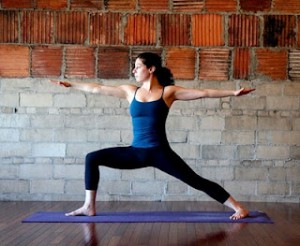From my perspective the feet shouldn’t change from Warrior 1 to Warrior 2.
Teachers teach is one of the oldest maxims out there. It has resonance in the yoga world because many people who lead yoga classes aren’t teaching. A lot of the people certified to teach yoga are leading people through some hard-core exercise routines— and more power to them. When I take yoga classes I am not interested in learning. I much prefer flow classes with a teacher I respect than classes like mine where someone talks endlessly and harps on doing things correctly. On a certain level I wish I could teach flow classes but I get bored quickly and like talking too much.
My classes don’t vary much in structure and I am very picky about little things, repeating the same instructions over and over again. But at the same time there are habits that I comment about but not often enough.
For this discussion we are talking about two different widths between the feet in standing poses. How far the feet are apart from the front to the back of the mat and how far are apart they are side to side.
Many students who take flow classes and move a through a lot of downward dog have a number of similar habits that I don’t necessarily understand. I find that vinyasa students tend to have very short standing poses in terms of the distance between the feet at the front and back of the mat. Warrior one for instance should be far apart enough so that the front knee is on top of the front ankle with that thigh parallel to the floor. That is no mean feat but it seems that many students moving into warrior poses from down dog don’t think too much about how far they step their foot forward.
I talk about the length of standing poses often enough but something I never talk about is how many students shift their feet in the transition from warrior 1 to warrior 2, most often bringing the feet further apart in terms of the distance between the legs. This makes no sense to me. I imagine that they are taught to do it but I can’t understand why.
The feet should be in the same plane for your traditional standing poses—warrior 1, warrior 2, extended side angle, triangle etc. Individuals can work their feet differently some might line up with their front heel bisecting the arch of the back foot, some might place the heels at right angles to each other while someone with tight hips might put an inch or two between the heels. But whatever that alignment is, it should be the same for all of your standing poses.
There is a sense of center that we should be looking for in the yoga practice. A conscious approach to building a balanced body that always leads back to tadasana, or Samasthithi, equal standing.

